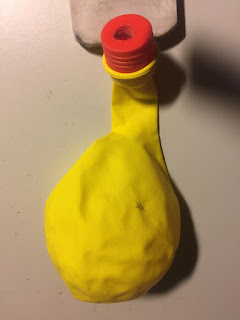An
inflated toy balloon follows an erratic track when the air escapes freely.
Would it be possible to let it float more or less stable in the air
with a controlled outflow? I managed to do exactly that by putting a
(glue stick) cap with a hole in the balloon outlet:
I started with a small hole. This did not elevate the balloon. By successively enlarging the hole I came to the point of floating. The mass of the cap makes sure that the balloon floats approximately upright.
I started with a small hole. This did not elevate the balloon. By successively enlarging the hole I came to the point of floating. The mass of the cap makes sure that the balloon floats approximately upright.
An
interesting question is whether we can calculate that the floating
condition is met. For that, the thrust by the escaping air should equal
the gravitation force on the balloon, the cap and the enclosed air.
I
measured the following:
- Diameter of the inflated balloon: D~ 25 cm.
-
Diameter of the hole in the cap: d~ 0.8 cm.
-
Time the balloon floated: t~ 10 s. In this time all air escaped.
-
Mass of balloon + cap: m~ 3 g.
-
Over-pressure in the balloon (measured with a contra/Huygens barometer): 18 mbar= 1800 N/m².
Assuming
the balloon is spherical, we compute the volume of the balloon as
4/3*pi*(25E-2/2)^3~ 8.2E-3 m^3. The gravitational force on the
balloon, the cap and the mass of the air inside is therefore:
Fg~ (8.2E-3 * 1.3 + 3E-3) * 9.8~ 0.13 N.
Here the density of air was assumed to be 1.3 kg/m^3. Note that the mass of the enclosed air is almost 4 times as much as the balloon+cap mass. One does not notice the air because its weight is balanced by the Archimedean upward force (that's also why a volume of air surrounded by air does not move spontaneously!).
The
thrust for this case is given by this equation (from
https://www.grc.nasa.gov/WWW/K-12/rocket/thrsteq.html):
Ft= me_dot * Ve + dp * Ae
The
meaning of the symbols is:
Ft –
thrust [N]
me_dot –
mass flow rate through the hole [ kg/s ]
Ve –
the air speed just outside the cap [ m/s ]
dp –
the over pressure in the balloon [ N/m² ]
Ae –
the area of the hole in the cap [ m² ]
The mass flow rate is me_dot~ (8.2E-3 * 1.3) / 10~ 1.1 E-3 kg/s.
The air speed just outside the cap can be computed by imagining the escaping air forming a cylinder of length L, with the ends having the area of the hole. The area of the hole is Ae~ pi * (0.8E-2 / 2 ) ^ 2~ 5.0 E-5 m^2. This cylinder goes through the hole in 10 s. So we have:
Ve~ (8.2E-3 / 5.0E-5) / 10~ 16.4 m/s.
We are now ready to compute the result of the thrust equation:
Ft= 1.1E-3 * 16.4 + 1800 * 5.0E-5~ 1.8E-2 + 9E-2~ 0.11 N.
This is quite close to the gravitational force Fg~ 0.13 N, notwithstanding assumptions as that the balloon is spherical, that we can see the escaping air as a cylindrical volume, etc. Of course, to validate the approach followed, this experiment should be repeated.
Note that the second term in the last equation is 5 times as large as the first term. This means that the thrust of the escaping air is negligible compared to the thrust due to the pressure difference between the balloon and the surroundings.
